Marketing Mix Report for Qantas
Info: 9750 words (39 pages) Dissertation
Published: 3rd Dec 2021
Tagged: Marketing
Table of contents
Click to expand Table of Contents
Introduction
Findings
1. The brand owners
2. The brand’s key characteristics and brand image
2.1. The brand’s key characteristics
2.2. Brand values/ brand image
3. Qantas customers
4. Qantas marketing strategies
5. Qantas marketing mix
5.1. Product range (see section 2)
5.2. Price
5.3. Place (distribution)
5.4. Promotion
5.5. People
6. How the various components of Qantas’ marketing mix are complementary?
7. Porter’s 5 Forces analysis of Qantas operating environment
8. Qantas adaptation of its marketing mix
9. The effectiveness of the brand’s current marketing mix
10. An opportunity for Qantas
10.1. Target Market
10.2. Product
10.3. Promotion
11. The benefits and investment related to this opportunity
11.1. A Human Resources audit consulting
11.2. Loyalty program update into Starcraft
11.3. New online platforms
11.4. Promotional material for Flying Kangaroo Sky campaign
Conclusion
Recommendations
Bibliography
Introduction
This report will identify the marketing strategies and marketing mix for Qantas, an airline company. It will then make recommendations to the brand owner related to an area where the marketing mix could be adjusted.
Specifically, the report will identify the owner of the brand and the key characteristics of the brand’s products and services and their significance to their markets. The report will describe the brand’s customers and their needs. The strategies and marketing mix will be elaborated upon, including a commentary on how the various components of the marketing mix are complementary and how successful the brand has been in achieving its marketing objectives and the strategic objectives of the brand owner.
The report will include a Porter’s 5 Forces environmental analysis for the brand. It will also discuss whether Qantas adapts any of its marketing mix to various geographic or demographic segments and, if so, how does this and why.
The report will also identify a specific opportunity that the brand could take advantage of and how it fits into the brand’s current strategic objectives. The benefits of pursuing this opportunity and the investment required will be explored. In taking advantage of this opportunity, Qantas will need to adjust some aspects of its current marketing mix and the report will make recommendations regarding these changes and will make other specific recommendations to the brand owner in relation to the proposed changes.
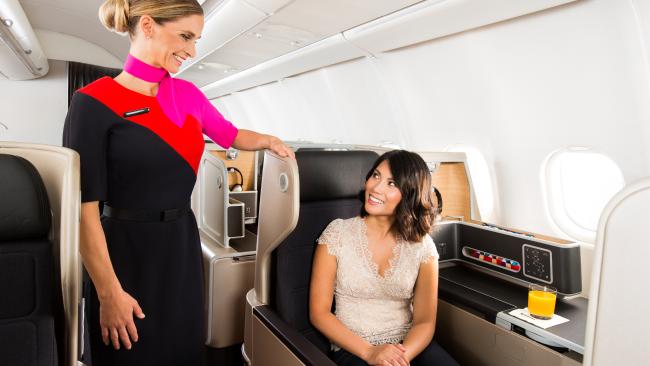
Findings
1. The brand owners
Originally, Qantas (an acronym for Queensland and Northern Territory Aerial Services) was founded by Sir Hudson Fysh, Paul McGinness and Sir Fergus McMaster in November 1920, with the presence of Arthur Baird since the beginning as the main engineer. In 1947, Qantas went through a nationalization process, which was only reverted from 1993 to 1997, coming to be again a private company.
Qantas has more than 130,000 shareholders, though the 20 major shareholders control about 80% of the company. The largest Qantas shareholder – with 22.72% of the company – is J. P. Morgan Nominees Australia, a division of the global J. P. Morgan investment house. The 2nd largest is HSBC Custody Nominees with 18.91%. Next is National Nominees with an 18.26% stake, and the 4th largest is Citicorp Nominees.
J. P. Morgan Nominees Australia, HSBC Custody Nominees, National Nominees and Citicorp Nominees are also the top four shareholders of Australia’s two largest resource companies: BHP-Billiton (world’s largest mining company, with copper, iron, gold, coal and oil reserves in its portfolio) and Rio Tinto (world-class mining company, with a broad portfolio which includes iron ore, bauxite, alumina, aluminium, copper, molybdenum, gold, diamonds, coal, uranium, titanium dioxide, borates, salt and talc). These four investing companies appear in the top 20 list of shareholders of many more companies, from Caltex to Leighton Holdings and Lend Lease.
Under Qantas brand umbrella, there are some subsidiary brands which target different markets: QantasLink (domestic flights, about 54 locations inside Australia), Jetstar (low-budget flights, created to fight off Virgin brand), Jetconnect (flights between Australia and New Zealand), QantasFreight (air cargo operations), SnapFresh and Q Catering (catering services) and Qantas Holidays (special holiday trips).





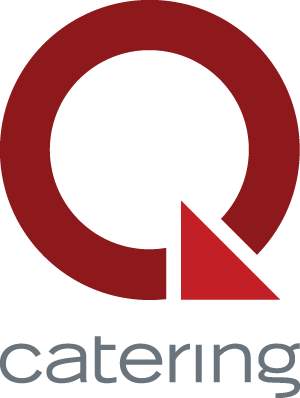

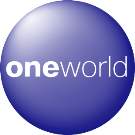
Qantas is also part of the airline alliance Oneworld, founded in 1999. Oneworld has as member airlines Air Berlin, American Airlines, British Airways, Cathay Pacific, Qantas, Iberia, Finnair, Japan Airlines, LATAM Airlines, Malaysia Airlines, Qatar Airways, Royal Jordanian, S7 Airlines and SriLankan Airlines, plus some 21 affiliated airlines, currently the 3rd largest global alliance in number of passengers (more than 557.4 million passengers carried), behind Star Alliance and SkyTeam. This airline alliance operates a fleet of 3,560 aircraft, serves about one thousand airports in more than 161 countries and generates annual revenues of more than US$130.9 billion.
2. The brand’s key characteristics and brand image
2.1. The brand’s key characteristics
Travel
The four types of travel have its travel classes as mentioned: International (Economy, Premium Economy, Business, First), Domestic and Trans-Tasman (Economy and Business), and Regional (Economy), each one with a full set of advantages. The First class is worth mentioning because of its Chauffeur Driver service included. There’s also a strong policy of allowing the best conditions for passengers with special needs such as blind people, accompanied by guide dogs or carers, physically disabled and many others. The Family Travel approach from the company dedicates to provide entertainment to underaged passengers through manual activities or electronic devices in order to keep these passengers relaxed most of the flight time.
Onboard Services
Alongside the well-known services provided by most airlines such as movies and series wide menus, inflight magazine, simple videogames and periodical meals and snacks, Qantas offers an inflight duty free online store, which grants Qantas Points for the Qantas Club (described below).
Airport Services
In the airport environment, Qantas offers its branded lounge for passengers waiting for their flights, airport guides and free wi-fi, with the following outstanding services: Qantas Valet Parking (only in some airports of Australia and in Auckland), Qantas Meeting Rooms (in Sydney, Melbourne, Brisbane, Adelaide, Perth, Canberra, Gold Coast, Townsville and Darwin) and the Dubai Connect (hotel stays for passengers who need this service in Dubai).
Other Services
The Qantas Frequent Flyer is a well-structured loyalty program (with about 9 million users) which grants Qantas Points from the following main sources (among minor ones):
- Flights from Qantas brand, its subsidiary brands, or its more than 35 partner airlines
- Use of some bank transactions from a number of partner banks
- Purchases at some partner supermarkets and shops
- Renting cars or booking hotel stays with some partners
- Employing the cash card Qantas Cash, which allows store a number or international currencies, under the MasterCard flagship
- As being a member of Qantas Assure Health and Travel Insurance
- Having meals in specific restaurants
- Purchases of wines and gourmet food experiences by becoming member of Qantas EpiQure
- As being a member of Qantas Golf Club
- Purchases of Qantas Holidays special activities


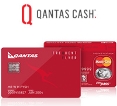



The acquired Qantas Points can be used to the following actions:
- Purchase flights
- Access to Qantas Club
- Purchase items at Qantas Store, from digital cameras and toys, to skydiving vouchers and skincare products
- Purchase hotel stays and car rentals
- Purchase wine and gastronomy experiences from Qantas EpiQure
- Purchase Qantas Assure services
- Woolworths WISH eGift Cards quarterly deducted, delivered by e-mail
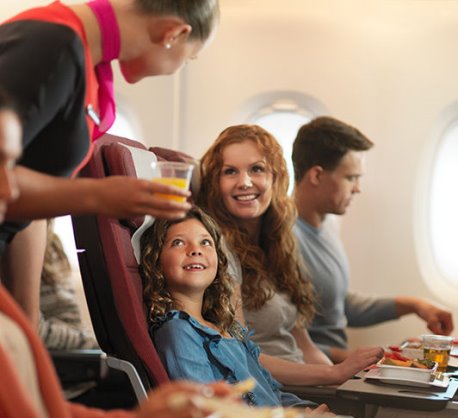
2.2. Brand values/ brand image
Qantas (sometimes nicknamed as the “Flying Kangaroo”) is dedicated to show the true values and imagery of Australia since its foundation in 1920. This Australian spirit incorporated in every single service of Qantas can be noticed in many details, beginning by the iconic kangaroo which is its logotype and is globally recognized, though this icon was only incorporated to the brand values when the company started making the “Kangaroo Route” by the time of II World War. Nevertheless, the kangaroo has evolved as an icon:






The connection from the brand to Australia can be easily pointed out by its massive presence over the Australian domestic flights (65% of them are made by Qantas and its subsidiary brands), it is the largest Australian airline and the 2nd oldest one. Another very important fact that adds pride from Australians towards Qantas is that it’s the only airline to ever develop its own airplane – it was designed by Arthur Baird himself.
The main values which Qantas tries to pass on through all its marketing efforts are Reliability, Safety, Customer Service Excellence, Operational Efficiency and High Technology. Despite its recent financial issues, the brand is still very strong worldwide and represents the Australian behaviour and expectations. Its slogan is exactly what it aims to communicate:
“The spirit of Australia”
In order to represent not only its connection to the urban Australian but also to the indigenous people from Australian isolated areas, the ones who have lived in the Australian territory for more than 40,000 years, Qantas has launched airplanes with special fuselage art representing the Aboriginal art.
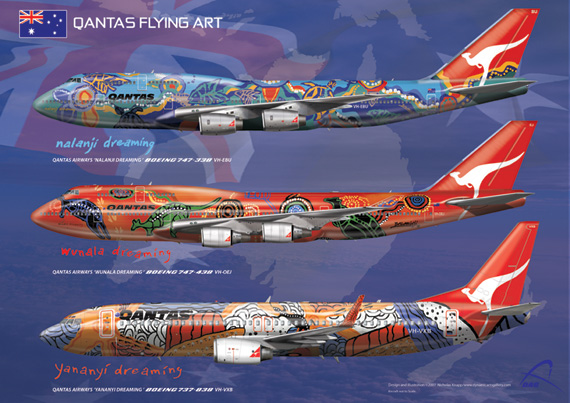

3. Qantas customers
The customers can be organized within a matrix distance x class:
| Regional | Trans-Tasman | Domestic | International | |
| Economy | Low cost | Low cost | Low cost | Low cost |
| Premium Economy | – | – | – | High quality |
| Business | – | Business | Business | Business |
| First | – | – | – | Luxury |
Due to this variety of customers, it’s not an easy task to point out the similarities among them all which could represent a reason all of them consume the Qantas brand and its services. Therefore, the market segmentation of Qantas airlines is complex, just because each segment has varied needs, requirements and expectations. This airline usually employs the behavioural segmentation for target market selection. As it happens to many other airline companies, the need to travel from one place to another are uncountable, as well as are the decisions to make the travel by airplane or not. Some of possible reasons for becoming a customer of an airline are:
- Quick domestic travel without depending on ground conditions (traffic, road conditions, weather affecting ground, responsibility for driving own vehicle)
- Crossing over seas or oceans, which would be impossible in time if by sea vehicles
Qantas’ target customers are business travellers travelling into or from Australia, which can be broken down into routine travellers, conference travellers or emergency business travellers. There are also leisure travellers, broken down into weekend tourists and multiple destination travellers.

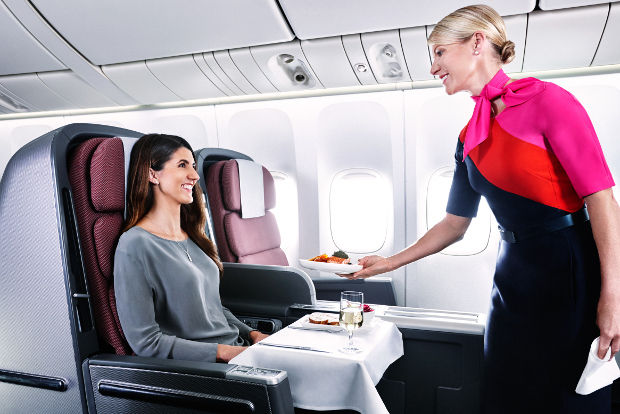
4. Qantas marketing strategies
The Qantas brand has a solid foundation and has accompanied all the political, economical, social and technological events in Australia, reinforcing year after year its commitment to the spirit of Australia and all its high-quality standards towards services, operations and technology. As said above, there are Aboriginal and Torres Strait Islanders initiatives from Qantas, not only using the aboriginal art into their airplanes but also having a hiring and training program which has made up to 2% of the company’s staff being of Aboriginal and Torres Strait Islanders origin. Qantas sponsors aboriginal artists on a regular basis, purchasing and then donating their arts to museums and other exhibition venues.
Its dismemberment from only one brand into several others (Jetstar, Jetconnect and QantasLink) is also part of the strategy, leading its customers to the best service packages, therefore remaining highly competitive in each attending market. Even its supporting brands (QantasFreight, Q Catering, SnapFresh and Qantas Holidays) have proven their effectiveness receiving their own management separated from the Qantas brand, which could then be properly managed through its core business and remain improving its services.
Adding even more value to its strategies, Qantas also uses the Frequent Flyer program, which has been evaluated in US$ 2 billion, approximately 25% of the total value of Qantas, a fact which proves the effectiveness by keeping close contact and a reliable loyalty system to its customers.
5. Qantas marketing mix
5.1. Product range (see section 2)
Qantas’ product range was elaborated upon in section 2.
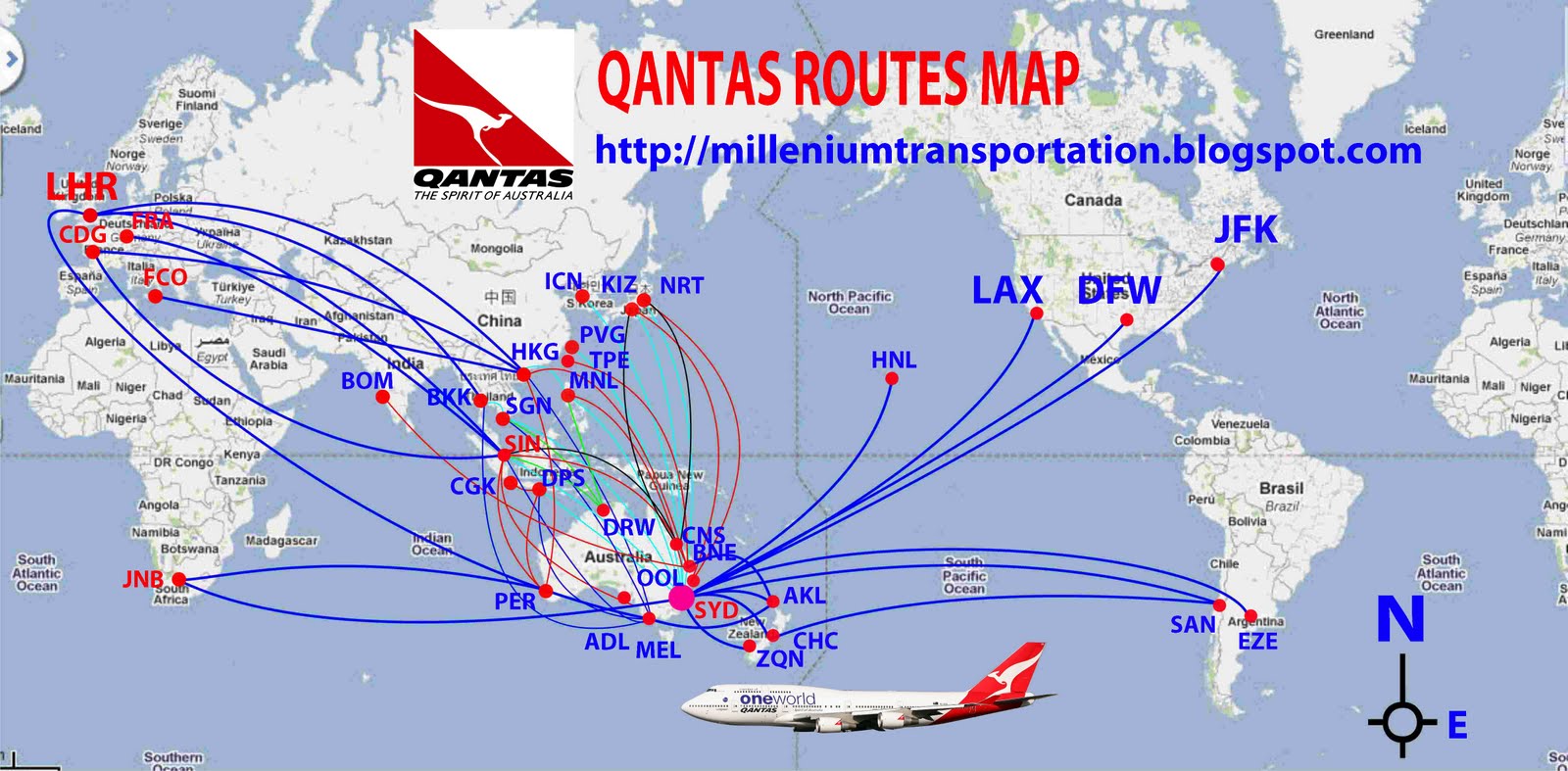
This airline is focused in domestic flights and also between Australia and New Zealand, but also offers international flights with concentration do Southeast, and then connecting Australia to the other continents by having routes to USA (North America), Chile and Argentina (South America), South Africa (Africa), some European countries (Europe) and UAE (Middle East).
Qantas adds up sophisticated and advanced aircrafts to its fleet at regular intervals.
5.2. Price
Since the fares of flights are so irregular and depend on many factors such as availability of seat, position of seat, travel class, date of flight, distance of flight and aggregated services separately purchased, it’s very difficult to establish a price chart to analyse. However, the main important data to be taken into account for Price are:
- “Cost + Margin” method usually used for product pricing, which makes markets with more demands have higher fares from Qantas, though competitive pricing methods are also used
- For Jetstar, the penetrative pricing due to its low cost approach
- The fair refunding policy provides customer flexibility and higher satisfaction
- Price discounts are provided without being portrayed as real discounts, in order to maintain the customer price perception
- Qantas also offers low pricing strategies for new destinations
- The Frequent Flyer program is a world class loyalty program which is recognized for offering customer benefits over expectations
5.3. Place (distribution)
Being Qantas basically a transportation service, the routes and geographical reach were considered in the Product subsection above, while this subsection will concentrate in details about airport services and where to find tickets for sale.
- Qantas Valet Parking only in some airports of Australia, and in Auckland
- Qantas Meeting Rooms in Sydney, Melbourne, Brisbane, Adelaide, Perth, Canberra, Gold Coast, Townsville and Darwin
- Dubai Connect
- Qantas Club in Sydney, Melbourne, Brisbane, Auckland, Los Angeles, Singapore and Hong Kong
- Direct sales are conducted from Qantas counters at the airports, while Qantas’ own retail outlets are used for ticket sales
- Due to the more and more use of Internet, Qantas’ website have its own e-commerce structure, but even phone calls can be used to buy tickets
- Travel agents (intermediaries) are used, expanding the network to many places which don’t even have airports
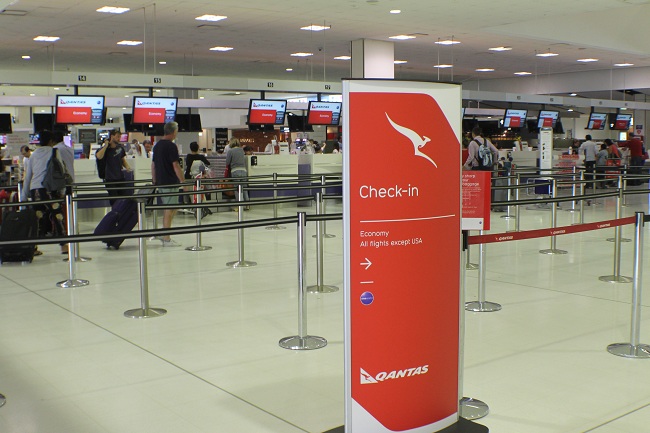
5.4. Promotion
Qantas has a wide variety of promotional strategies, each one developed for a specific demand, target market and result.
Regarding to Advertising, such as TV, radio, online advertising, OOH formats, brochures, print vehicles (newspapers and magazines) etc., all these formats are used for the purposes of branding and product promotion. Currently, the Qantas image is more emotional and focused on gathering of people, but its 1969 campaign was very different and was considered one of the best campaigns of all time – the success was enough to keep the koala in the next 20 years of Qantas campaigns, with different approaches.
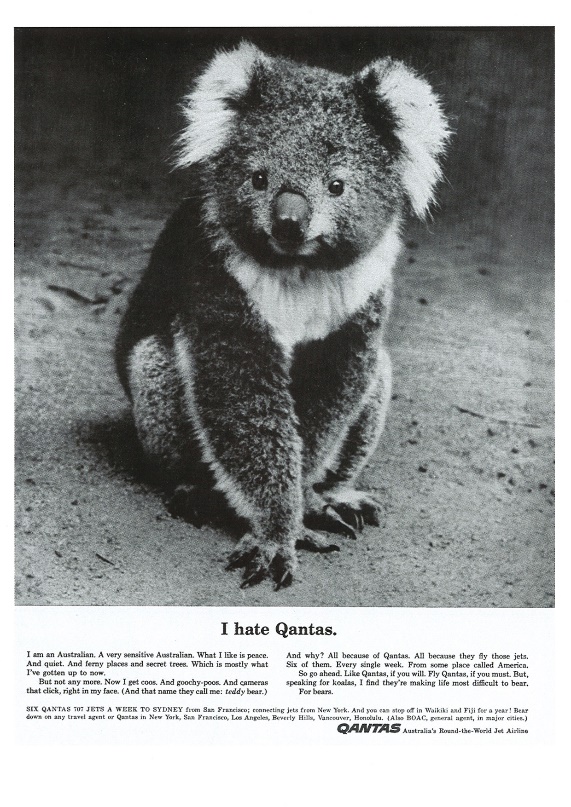
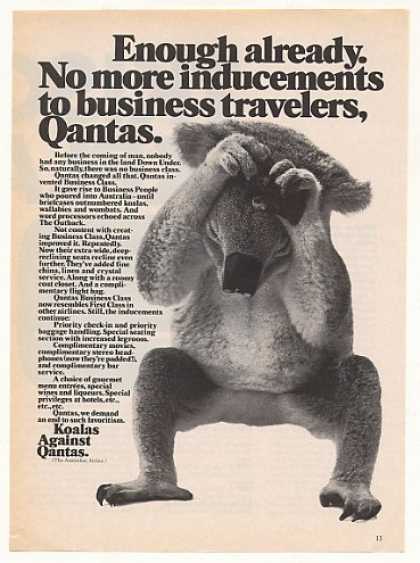
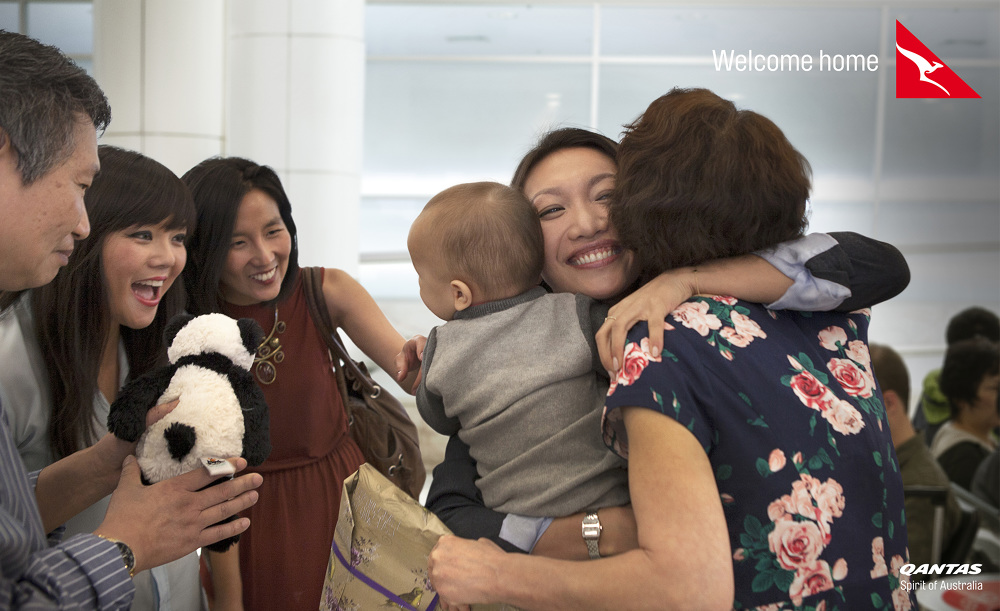
Direct marketing is used to send across customized messages for each customer, to hit them at a personal level. This strategy has so far been very successful, as it can be seen by the ever-growing Frequent Flyer program. Sales promotions are used during low seasons and direct selling is also used for corporate customers.
Social networking (specially in Facebook, Instagram and YouTube) and blogs are used to get closer to customers using their daily language and interests. Qantas also makes various other marketing stunts such as PR activities, sponsorships of sports (being the Qantas Wallabies rugby team, the Socceroos soccer team the directly sponsored teams; Qantas also sponsors the Formula One Australian Grand Prix and transports the Australia national cricket team) and also event art & entertainment related programs, involvement and sponsorship of various charitable programs. The Qantas brand ambassadors around the world are the actor John Travolta, the golf player Greg Norman, the model Miranda Kerr, the pilot Mark Webber and the athlete Cathy Freeman.
5.5. People
Qantas has gone through an intensive change in management, which included cutting of prices and labour costs in order to ensure the high productivity, moderation of the wages and the introduction of flexible structures through a versatile and motivated workforce. All these efforts have in mind that this company delivers a service and not a simple product, which means the Qantas staff is more important than any equipment – maybe even more important than the aircrafts themselves. No matter which travel a passenger takes, the Qantas workforce is the real bridge between the brand and the customer, so they must be always motivated and prepared for all demands. In order to keep these values always satisfactory, the HR team operates in four major areas:
- Corporate: employees’ remuneration and benefits, industrial relations of Qantas with competitors, and development of the HR management
- Business: ensure successful delivering of strategies that might grant competitive advantage
- Shared Services: managing workers records, supporting remuneration and recruitment process and managing employees’ compensation, as well as developing strategic plans on staff travelling schedules and schemes
- Development & Learning: training programs for employees to help them deliver their work effectively
Since its privatization, Qantas has been facing challenging issues involving wage policy and training for pilots, which have reflected in the series of outcries from the workforce who wanted fair salaries aligned to the average from the competitor companies, and also the navigation mistakes committed by pilots and massively reported on mass media, impacting directly the profits and the brand value of Qantas from the beginning of 2000s to 2013, when new policies were introduced in order to solve such matters.
6. How the various components of Qantas’ marketing mix are complementary?
Before the analysis of how each P had synergy with one another, a brief SWOT matrix should be presented in order to summarize important data and then allow the necessary analyses:
| STRENGTHS | WEAKNESSES |
|
|
| OPPORTUNITIES | THREATS |
|
|
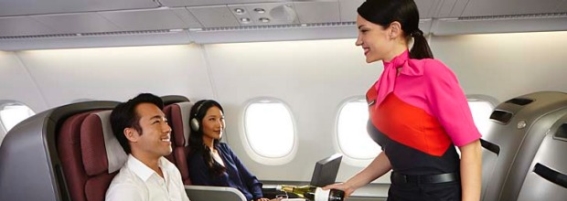
| Qantas | Virgin Australia | |
| Price |
|
|
| Product |
|
|
| Place (distribution) |
|
|
| Promotion |
|
|
| People |
|
|
By the comparison above, it´s possible to see the Qantas brand as more competitive than Virgin Australia, even with the uncomfortable issues to solve towards the expectations from its workforce. It’s starting new Human Resources Managements initiatives aiming to reorganize the company and fight off the dissatisfied employees, while the top executives still must align every expectation and speech in order to achieve a simple strategy which could reflect every shareholder’s objectives.
7. Porter’s 5 Forces analysis of Qantas operating environment
| Existing rivalry | High
The competitive rivalry in airline industry has been increasing, especially through mergers, acquisitions and subsidiaries. Qantas established its low-cost airline Jetstar in 2003, creating a two-brand strategy. New rivals have emerged following the footsteps of Qantas, such as Singapore Airlines and British Airways, and are threatening Qantas’ market share in the no-frill, low-price trade by offering lower costs and attending customer service. One of the major differentiators in this field is the number of direct flights that are being offered where the major players will have an edge but with the price factored into this calculation; this advantage is also being taken out these days. Qantas is competing directly with Virgin Australia in the domestic market, and the competition is so severe that these airline companies are suffering losses in their operations. |
| Threat of new entrants | Low
For domestic players, the entry can be much easier in terms of licenses and the fact that in the initial stages most of the other peripheral operations may be outsourced. But the capital outlay involved, the time taken to break even and the available landing slots in Australian airports in this case has held back many from entering into this field. In terms of international routes, the entry barriers are high and one need to plan out the entry in this industry as the competition is so huge that it is so very easy to be sidelined in the market. |
| Threat of substitutes | Medium
There are many substitutes for airlines, especially in the shorter routes such as buses, trains, cars, cruise boats and other transportation modes. This may not be true for the long distances anyways but with the advent of technology, there are many options like the net meetings, video conferences and video messages that has been a substitute but not as effective. |
| Buyer power | High
In aviation industry, the buyer power is higher as most of the routes are being covered by more than one operator and at the same time there is a huge competition in terms of the prices which gives sufficient power to the customers |
| Supplier power | High
Considering the investments the airlines make for suppliers, the high value orders and the limited amount of suppliers of aircrafts, the airlines remain in a very dependable situation. Another factor that affects the aviation industry is the fuel pricing, where the suppliers don’t have control and it is decided by political factors across the globe. |
8. Qantas adaptation of its marketing mix
Qantas is focused on the domestic market, but also offers international routes (by the Oneworld Airline Alliance). Due to this fact, the main adaptations will be done accordingly to geographical segmentation, with some adaptations through demographic segmentation.
These can be summarized in the table below:
| Component | Adaptation? |
| Product | Australia: Wide variety of domestic destinations
New Zealand: High flow of flights through Jetconnect Southeastern Asia: Good variety of international destinations Africa, Americas, Europe and Middle East: Very limited international destinations |
| Price | First: Chauffeur Driver and many other inflight and airport benefits |
| Place | Australia: Many benefits in domestic airports
New Zealand: Benefits in Auckland airport Southeastern Asia: Some outstanding benefits in some airports Africa, Americas, Europe and Middle East: Benefits in very few airports |
| Promotion | Australia and New Zealand: consistent, emotional and regular advertising campaigns and sponsorship strategies
Others: very limited and rare advertising campaigns |
9. The effectiveness of the brand’s current marketing mix
The most valuable asset of Qantas is its brand image among Australians, successfully achieved even with the issues from the past decade. This brand image is a powerful driving force that is capable of reversing any hindrance or weakness is correctly employed over the target markets and all its stakeholders. The most remarkable achievements of Qantas current marketing mix are the following:
- Absolute presence and leadership in Australian territory
- Recognition as a high-premium airline
- Successful connections across the globe through Oneworld Alliance
- Jetstar subsidiary as a highly competitive low-cost airline
- Frequent Flyer program, with its 9 million members and an award-winning structure and mechanics
- Many benefits in airports to its clients
Even with such remarkable achievements from Qantas, the company still has some crucial topics to deal with in order to reach better marketing results. All the achievements listed above are perfectly achievable by Qantas’ competitors (especially Virgin Australia, with its aggressive marketing approach. There are some interesting topics to point out about growth opportunities for Qantas.
The accessible technology to customers must always be evolving, especially through mobile apps which will offer many more interaction opportunities between its users to the brand. Being informed about best fares, online purchase, check-in and seat selection, aircraft map, Qantas Points management, luggage tracking, and any other service that technology is able to provide. Qantas’ direct competitors (Virgin Australia, British Airways and Singapore Airlines) are very advanced in this, so Qantas must innovate in this matter.
The technology in aircrafts is clearly an important topic, and must be managed in a high pace in order to provide not only the passengers a resourceful and safe travel, but also the crew the needed safety and efficiency through their equipment.
Qantas’ Frequent Flyer is globally recognized and admired, but Virgin Australia’s Velocity loyalty program is becoming more and more attractive to customers, having received some awards in recent years. It’s mandatory that Qantas watch and improve its Frequent Flyer program in order to make it the best one in all its area of reach.
Though hegemonic in Australia and with massive routes to Southeastern Asia, Qantas must expand its routes to more potential places which could represent profitable flights, such as Eastern Europe, Middle East, South America, North Africa and more cities in USA. The Oneworld Alliance must be taken as an advantage for that while Virgin Australia is not part of any other Airline Alliance. The countries with highest potential to be served by Qantas are Brazil, Canada, Colombia, Egypt, Israel, Oman, Qatar, Russia, Sweden and Turkey, considering purchase power and better points to expand the routes network.
While Qantas should expand its routes across the globe, its Qantas Club should follow the same logics, though it’s clear that it wouldn’t need to exist in every airport attended by Qantas. However, South Africa, UAE and some countries in Europe (especially England) should have the Qantas Club in order to concentrate more travels from interested passengers.
Virgin Australia is very aggressive in its advertising and publicity strategies, fighting off Qantas’ image from the target market’s share of mind and recall. It’s a priority for Qantas to reformulate its brand strategy in advertising in order to fight Virgin Australia with equal forces.
The labour issues from past years still reflect on dissatisfaction and mass media approaches, attacking Qantas’ brand image with no way of dealing with this brand erosion while the real problem is not permanently solved. Human Resources Management and Endomarketing strategies must be swiftly activated in order to keep the majority of employees satisfied and able to act as brand ambassadors in each and every situation.
The high amount of shareholders and the power concentrated in a very few of these shareholders is still a major problem, leading to contradictory and conflicting decisions among them. A stronger and more aligned structure must be organized.
10. An opportunity for Qantas
The Flying Kangaroo Sky Marketing Campaign
Gradually, Qantas is losing its strong image while its competitors gain more and more share of market, especially outside Australia. In order to revert that, a strong marketing campaign must be activated in many simultaneous situations, emphasizing not only the Spirit of Australia as something to engage Australians, but also a way of life to be exported and presented to the overseas passengers.
10.1. Target Market
Since it’s a multilevel Marketing Campaign, it’ll potentially reach anyone, but prioritising the following ones:
- Qantas employees, in any area and time working for the company
- Passengers in any age, any gender and socioeconomic class (the passenger clusters will be detailed below)
- Government
- Shareholders
- Oneworld
All the Marketing Campaign will be based on the image of the Flying Kangaroo and the Australian Sky made of stars, each star representing a Qantas employee. Mobile app, PR and advertising campaign, sponsorship, social media and loyalty program are the lines of approaching.
10.2. Product
Qantas employees: The mobile app will provide before-and-after flight details such as the correct time in the destination city and in the departure city, the name and brief description of the crew and the aircraft and an enquiry asking to decide which will be the constellation of the crew during that flight, based on Aboriginal constellations. Apart from a better wage policy and more training and learning programs, the employees also will receive more Qantas Points and will be able to enjoy these benefits more often than before.
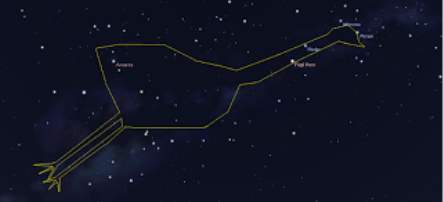
Passengers: The mobile app will describe the crew in the flight as stars in the constellation chosen by the crew itself, the details about the aircraft, time in departure and destination cities and Qantas’ recommendations of tourism in the destination. Inflight, the movies, series and concerts will emphasize Australian productions, directors, actors and musicians (especially the most famous such as George Miller, Nicole Kidman, Hugh Jackman, Kylie Minogue, AC/DC, Paul Hogan, Chris Hemsworth, Russel Crowe, Cate Blanchett, Heath Ledger, Mel Gibson, Men At Work, Silverchair, Bee Gees, Baz Luhrmann, Peter Weir, Phillip Noyce and P.J. Hogan, among others). Along with the current videogames, a new one developed to engage the player into collecting stars and boosting the capacities of the aircraft will be an addition for this kind of emotional involvement of underaged passengers and even young and older ones. The Frequent Flyer program will be improved and then the members will receive better rewards which will be easily controlled by the mobile app.
Government: The governmental relations must be strictly kept, since it can help Qantas in any economic turmoil and also will protect a national brand against foreign ones. As result from better legal conditions granted by the Government, Qantas offers the Frequent Flyer program to all Government employees of legislature, executive, and judiciary power branches, letting all these politicians use Qantas Points when in private travels (non-Governmental purposes).
Shareholders: Qantas itself will provide guidance and bureaucratic help for all minor shareholders in order to create a force which could represent all them and, therefore, give them voice in the company’s decisions, not letting these decisions made only by the major shareholders. This force will be called Alkira (whose meaning is “sky” by some aboriginal peoples in Australia), with its own brand image and direct communication through e-mail, social media groups and meeting room decoration.
Oneworld: The deals with allied airlines must be more and more expanded in order to keep a sustainable revenue and then transporting more passengers to more options; Qantas must be seen as an example to be followed, a standard setter among its allies from Oneworld. By simply being the most competitive and innovative among them, its brand image will be naturally transmitted to further locals.
10.3. Promotion
Qantas employees: The internal communications channels (intranet, e-mail, payroll, message wall, social media groups, office decoration, corporate film) will all communicate the employees are stars in the Flying Kangaroo Sky (which first constellation is the Flying Kangaroo itself, composed by the four stars that represent the four founders). The highly emotional tone of this internal campaign will reflect the efforts in better wages and trainings, making each of them a crucial star in the whole Qantas sky. During one whole year, internal events will have lectures about the Flying Kangaroo Sky campaign, reinforcing the brand values and the importance of the employees as brand ambassadors. During this same year, the Qantas Points will be focused on offering very cheap costs for places related to stargazing, in and out of Australia.
Passengers: A very persuasive and massive advertising campaign for TV, radio, out-of-home, airport indoor, magazine, newspaper, internet and social media will communicate the Flying Kangaroo Sky approach, showing the top quality of Qantas workers and aircrafts and the experiences over expectations. Depending on the budget, high-estimated Australian artists will be turned into poster boys, giving testimonials of Qantas value as an Australian premium brand. The sponsored rugby and soccer teams (and any other sponsored teams) will be considered “part of the Flying Kangaroo Sky”, as comets crossing the sky each time the sky must be visually represented. The Frequent Flyer loyalty program will be reformulated in mechanics and also in branding, under the new name Starcraft – all current members will receive a direct mail with a representation of a flying ticket to the starcraft, explaining the new advantages of this loyalty program and inviting them to keep travelling among the Flying Kangaroo Sky’s stars.
Shareholders: Before and after each meeting of shareholders, the minor shareholders who are part of Alkira group will receive branded communication informing about the subjects and decisions from the meetings, always inviting them to understand their role and importance in the Flying Kangaroo Sky, “since they are the sky itself”. A corporate film must be made and presented to the Alkira members at the first time possible, then must be accessible to them anytime, with periodical direct mail based on selected parts of this film in order to reinforce the whole message in their memories.
Oneworld: In any event organised by Oneworld, at least one brand ambassador of Qantas must make a lecture or workshop, demonstrating to the audience the high quality of services, the improvements done towards the employees and the technological innovations achieved by the time. One special corporate film must be made reflecting all the innovations, to be used each time a Qantas brand ambassador will present himself at an event by Oneworld. In media channels owned by Oneworld, Qantas will air advertisements during the whole campaign’s launching year.
11. The benefits and investment related to this opportunity
The main benefits forecasted by activating the Flying Kangaroo Sky campaign are the strengthening of Qantas brand equity, the achievement of better alignment among major and minor shareholders, and increase of flight ticket sales, followed by an increase in memberships in Frequent Flyer (Starcraft) loyalty program.
The investment requirements are as follows:
11.1. A Human Resources audit consulting
The first and essential job for the true and innovative changes in Qantas regards to the training and motivation of its employees, and it must be monitored and controlled rigidly during the time of implementation of the campaign in order to not let the message be seen as fake by both employees and customers. Then, during one whole year, constant audits from an HR Consulting will be part of Qantas chores, checking and, when necessary, fixing the unaligned situations between employees and employer.
It is expected to be spent about AUD$ 40,000.00 on an HR auditing project, though this value may change depending on the kind of negotiation, frequency of audits and the decision from the shareholders.
11.2. Loyalty program update into Starcraft
The Frequent Flyer is globally recognised as a successful program and also as an important asset in Qantas, but the Velocity loyalty program from Virgin Australia is growing in a very quick pace and has received some global awards about its efficiency and innovativeness. With no reformulation, Frequent Flyer will decrease its value and efficiency in a short time, and it’s a lot more expensive and demands more struggle to recover lost members than to update the current system and maintain the members satisfied.
In order to analyse and implement a new loyalty program as an update of the previous one, it’s expected to spend AUD$ 500,000.00 for the global program with a partner loyalty programs developer.
11.3. New online platforms
Either the current digital development suppliers or new ones will deliver:
- a new website wholly “dressed” in the Flying Kangaroo Sky campaign
- a new mobile app update with the campaign elements and new functionalities
- visual material aligned to the campaign for the social media profiles
- a new website for the Alkira minor shareholders
- a new website wholly “dressed” in the new Starcraft brand image and presenting the new loyalty program update
- an advergame to be accessed by passengers inflight and in Qantas website
These five deliverables are expected to cost about AUD$ 150,000.00, but with high probability of reaching more expensive costs depending on the digital developers.
11.4. Promotional material for Flying Kangaroo Sky campaign
This campaign will reach different target markets in various communication channels, demanding many advertisements and versions for them:
- Intranet cover art, e-mail art, payroll frame art, message wall poster, social media groups arts (static and animated GIF), office decoration (monitor frames, badges, mousepads, pencil holders, pens, pencils, mugs, squeezes) and corporate film, for the Qantas employees
- TV spots (2’, 30” and 5”), radio spot (30”), out-of-home ads (billboards, electronic panels), airport indoor ads (billboards, electronic panels, airports websites, spots for airports radios), magazine ads (double-page), newspaper ads (double-page), internet ads (various formats in websites related to travel, tourism, aviation, business and family) and social media ads (static and animated GIFs, owned and paid channels), for the Qantas customers and prospects
- Direct mail and e-mail with special art developed for current members of Frequent Flyer explaining that the loyalty program has been updated as well as its website, and that it’s now called Starcraft loyalty program
- Direct mail, e-mail and corporate film produced specially for the member of Alkira hub of minor shareholders, reminding them of their importance for the company – the film will be hosted in the Alkira website, which will be accessed through login and password owned only by the members.
- Corporate film, indoor ads (posters and large displays) and magazine ad arts will be produced only to emphasise the evolution of Qantas through the Flying Kangaroo Sky campaign in every Oneworld event and owned communication channel.
Considering at least 1 year producing all these promotional materials, AUD$ 1,000,000.00 will be spent only with creative works and production costs. For the airing media plan, a global budget of AUD$ 20,000,000.00 will be divided into the main locations (Australia, New Zealand, Los Angeles, Santiago, South Africa, Dubai, England, France, Italy, India, Hong Kong, Vietnam, Thailand and Singapore). An extra budget of AUD$ 80,000.00 will be employed in translations for Spanish, Arab, French, Italian, Hindi, Mandarin, Vietnamese and Thai (AUD$ 10,000.00 for each translating version).
Summarizing every task and their costs:
| SERVICE | COST |
| Ongoing HR auditing project | AUD$ 40,000.00 |
| Loyalty program update with partner developer | AUD$ 500,000.00 |
| New online platforms | AUD$ 150,000.00 |
| Creative and production costs for promotional materials
Global budget for media buying Translation of campaign into eight languages |
AUD$ 1,000,000.00
AUD$ 20,000,000.00 AUD$ 80,000.00 |
| TOTAL | AUD$ 21,770,000.00 |
Conclusion
Qantas is an Australian airline with more than 130,000 shareholders and control over more than 65% of the domestic flights. There are subsidiary brands which target different markets: QantasLink (domestic flights), Jetstar (low-budget flights), Jetconnect (flights between Australia and New Zealand) and others. Qantas is also part of the airline alliance Oneworld, founded in 1999.
The four types of travel have its travel classes as mentioned: International (Economy, Premium Economy, Business, First), Domestic and Trans-Tasman (Economy and Business), and Regional (Economy), each one with a full set of advantages. Alongside the well-known services provided by most airlines such as movies and series wide menus, inflight magazine, simple videogames and periodical meals and snacks, Qantas offers an inflight duty free online store, which grants Qantas Points for the Qantas Club. In the airport environment, Qantas offers its branded lounge for passengers waiting for their flights, airport guides and free wi-fi, with the following outstanding services in some airports across the world: Qantas Valet Parking, Qantas Meeting Rooms and the Dubai Connect. The Qantas Frequent Flyer is a well-structured loyalty program (with about 9 million users) which grants Qantas Points to be used in various situations.
The main values which Qantas tries to pass on through all its marketing efforts are:
- Reliability
- Safety
- Customer Service Excellence
- Operational Efficiency
- High Technology
Its slogan is: “The spirit of Australia”.
Its main issues are:
- The accessible technology to customers must always be evolving
- The technology in aircrafts is clearly an important topic, and must be managed in a high pace
- Frequent Flyer loyalty program is getting outdated when compared to the emerging ones in the same region
- Oneworld Alliance must be used as an advantage for achieving more routes and destinations across the globe
- Qantas Club should expand to some key markets
- Qantas must reformulate its brand strategy in advertising
- Human Resources Management and Endomarketing strategies must be swiftly activated in order to keep the majority of employees satisfied and able to act as brand ambassadors in each and every situation
- A stronger and more aligned structure among major and minor shareholders must be organized
This report has recommended that the brand owners launch an advertising campaign aimed to multiple target markets, using several communication channels (paid ones, previous own ones and new own ones) and innovating the loyalty program and the decision-making process from the minor shareholders, also establishing high standards for training and wage policy with employees.
By doing so, the main benefits forecasted are the strengthening of Qantas brand equity, the achievement of better alignment among major and minor shareholders, and increase of flight ticket sales, followed by an increase in memberships in Frequent Flyer (Starcraft) loyalty program.
The projected budget for activating all the necessary actions is AUD$ 21,770,000.00, but it may vary according to the selected partners and suppliers for each action.
Recommendations
To take full advantage of the opportunities identified in this report, Qantas brand owners need to:
- Update and launch new digital platforms, namely the websites and mobile apps
- Update its loyalty program and inform about it to its members
- Strengthen the partnership with the airlines from the Oneworld Alliance
- Solve the mismanagement issues from the shareholders unalignment
- Achieve a peaceful and satisfactory relationship with all the employees
- Launch an aggressive and persuasive advertising campaign in order to recover recall and share of mind
Bibliography
Branding / Marketing / Qantas Australia. https://pt.slideshare.net/rimapurwari/branding-marketing-qantas-australia – Last visit: 13 Apr 2017.
Description Of Qantas And Hrm Activities Management Essay. https://www.ukessays.com/essays/management/description-of-qantas-and-hrm-activities-management-essay.php – Last visit: 13 Apr 2017.
Pestel and Porter’s Five Force Analysis of Qantas Essay. https://studymoose.com/pestel-and-porters-five-force-analysis-of-qantas-essay – Last visit: 13 Apr 2017.
Qantas. http://www.qantas.com/ – Last visit: 13 Apr 2017.
Qantas. https://en.wikipedia.org/wiki/Qantas – Last visit: 13 Apr 2017.
Qantas Airlines: Strategic Analysis. http://www.assignmenthelpsite.com/upload/2014/11/Strategic-Analysis-Of-Qantas-Airlines.pdf – Last visit: 13 Apr 2017.
Qantas Airways. http://mundodasmarcas.blogspot.com.au/2006/06/qantas-airways-spirit-of-australia.html – Last visit: 13 Apr 2017.
Qantas Airways SWOT Analysis, USP & Competitors. http://www.mbaskool.com/brandguide/airlines/536-qantas-airways.html – Last visit: 13 Apr 2017.
Qantas Strategic Assignment Help. http://australianassignmenthelp.com/qantas-strategic-assignment-help – Last visit: 13 Apr 2017.
The Qantas Marketing Mix Marketing Essay. https://www.ukessays.com/essays/marketing/the-qantas-marketing-mix-marketing-essay.php – Last visit: 13 Apr 2017.
[Virgin Australia] SWOT Analysis. https://prezi.com/5-zobh_v8-jh/swot-analysis/ – Last visit: 13 Apr 2017.
Who owns Qantas? https://www.wsws.org/en/articles/2011/10/qown-o31.html – Last visit: 13 Apr 2017.
Cite This Work
To export a reference to this article please select a referencing stye below:
Related Services
View allRelated Content
All TagsContent relating to: "Marketing"
Marketing can be described as promoting and selling certain products or services to meet the needs of the customer. Tasks involved with Marketing include market research, content creation, advertising, and more.
Related Articles
DMCA / Removal Request
If you are the original writer of this dissertation and no longer wish to have your work published on the UKDiss.com website then please:




